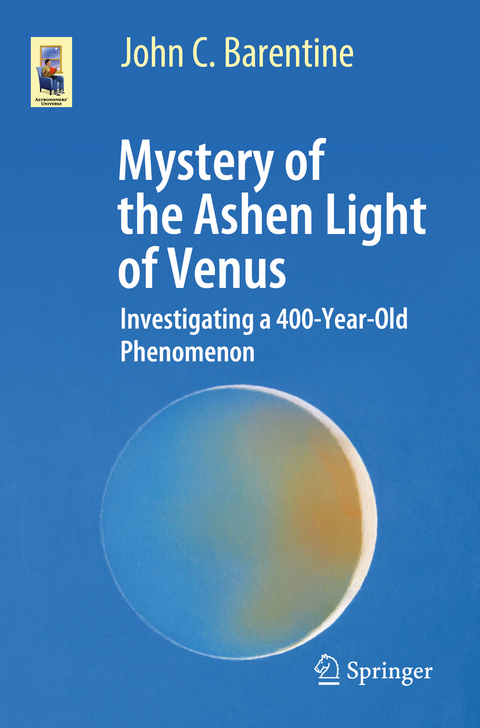
Mystery of the Ashen Light of Venus
Springer International Publishing (Verlag)
978-3-030-72714-7 (ISBN)
The "Ashen Light" of Venus-a ghostly emission of light from the night side of our nearest planetary neighbor-is among the last unsolved mysteries of astronomical history. In the four centuries since the phenomenon was first reported, highly reputable visual observers of Venus have recorded seeing the Ashen Light, while others have spent a lifetime searching for it without once being convinced that they ever saw it.
Is the Ashen Light a trick of the eye? The result of a defective lens? A real scientific event?
Occasional references to the Ashen Light are scattered across the literature, yet no work to date has synthesized these records. This book therefore digs deep into the history of the mystery and our latest attempts to understand it, sifting through the clues that might explain whether it is caused by physics, is conjured up by the eye or brain, or a combination of both.This baffling story will appeal to amateur astronomers, hobbyists, and lay readers interested in joining the debate about one of the most elusive observable phenomena ever recorded in the night sky.
John Barentine currently serves as the Director of Public Policy for the International Dark Sky Association (IDA) in Tucson, Arizona. He grew up in the Phoenix area and was involved in amateur astronomy there from early on. Later, he attended the University of Arizona, doing research at the National Optical Astronomy Observatories and National Solar Observatory headquarters in Tucson. From 2001-06 he was on the staff of Apache Point Observatory in New Mexico, serving first as an observing specialist on the Astrophysical Research Consortium 3.5-m telescope and then as an observer for the Sloan Digital Sky Survey.
John obtained a master's degree in physics at Colorado State University and a master's and doctorate in astronomy at the University of Texas at Austin. John has contributed to science in fields ranging from solar physics to galaxy evolution while helping develop hardware for ground-based and aircraft-borne astronomy. Throughout his career, he has been involved in education and outreach efforts to help increase the public understanding of science. In addition to his work for IDA, John is a member of the steering committee of the University of Utah Consortium for Dark Sky Studies and the International Union for Conservation of Nature Dark Skies Advisory Group. In 2018, he was elected a Fellow of the Royal Astronomical Society.
John is the author of two books on the history of astronomy for Springer: "The Lost Constellations" and "Uncharted Constellations." The asteroid (14505) Barentine is named in his honor. His interests outside of astronomy and dark skies include history, art/architecture, politics, law and current events.
Chapter 1. Prologue: The Martians that never were.- Chapter 2. "I could see the dark part of Venus...".- Chapter 3. First Light: Early accounts of the Ashen Light 1643-1800.- Chapter 4. Going mainstream: A scientific approach c. 1800-1900.- Chapter 5. What is the light? Historical explanations of the Ashen Light.- Chapter 6. Venus as a knowable world: Chasing the Ashen Light into the Space Age 1900-1980.- Chapter 7. New ideas for an old problem: Observations and science 1980-2020.- Chapter 8. Seeing what we want to see: The psychology of the Ashen Light.- Chapter 9. Perception revisited: The psychophysics of the Ashen Light.- Chapter 10. Epilogue: Evanescence and evasion.
"This is a thought provoking, nicely produced, and inexpensive book for the general reader, and the explanations of the diverse physical processes involved are always detailed and very clearly explained. ... I would still recommend the book." (Richard McKim, The Observatory, Vol. 142 (1289), August, 2022)
“This is a thought provoking, nicely produced, and inexpensive book for the general reader, and the explanations of the diverse physical processes involved are always detailed and very clearly explained. … I would still recommend the book.” (Richard McKim, The Observatory, Vol. 142 (1289), August, 2022)
| Erscheinungsdatum | 09.09.2021 |
|---|---|
| Reihe/Serie | Astronomers' Universe |
| Zusatzinfo | XVI, 257 p. 49 illus., 18 illus. in color. |
| Verlagsort | Cham |
| Sprache | englisch |
| Maße | 155 x 235 mm |
| Gewicht | 426 g |
| Themenwelt | Sachbuch/Ratgeber ► Natur / Technik ► Weltraum / Astronomie |
| Naturwissenschaften ► Physik / Astronomie ► Astronomie / Astrophysik | |
| Schlagworte | 17th century astronomy • Ashen Light • Ashen Light 1643 • dark side of venus • martian canals • observing Earthshine • observing Venus • Venus 17th century • Victorian astronomy |
| ISBN-10 | 3-030-72714-9 / 3030727149 |
| ISBN-13 | 978-3-030-72714-7 / 9783030727147 |
| Zustand | Neuware |
| Haben Sie eine Frage zum Produkt? |
aus dem Bereich


